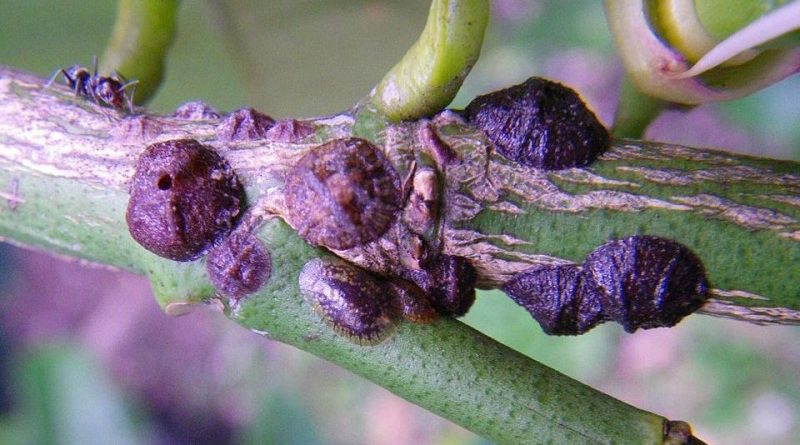Saissetia oleae
Saissetia oleae
The cochineal half a grain of pepper (Saissetia oleae Olivier, 1791) is a phytomizous insect belonging to the Coccidae family.
Systematics –
from the systematic point of view it belongs to the Eukaryota Domain, Kingdom Animalia, Eumetazoa Subarray, Bilateral Branch, Phylum Arthropoda, Subphylum Hexapoda, Insecta Class, Pterygota Subclass, Exopterygota Cohort, Subcoorte Neoptera, Paraneoptera Superorder, Rhynchotoidea Section, Rhynchota Order, Suborder Homoptera, Section Sternorrhyncha, Coccoidea Superfamily, Coccidae Family and then to the Genus Saissetia and to the S. Oleae Species.
Geographic Distribution and Habitat –
The Saissetia oleae is a Coccide most likely of South African origin but now widespread in areas with a mild and temperate climate; however, it is also present in colder areas where it lives and reproduces above all in the enclosed areas.
Morphology –
The Saissetia oleae is an insect that is characterized by its high polyphagia and prolificity. The female lays on average 1000 eggs and when ripe it has a very convex body of blackish color and of variable size from 2 to 6 mm of length, with a characteristic relief on the back with transverse H or with cross of Lorena. The male is particularly rare inasmuch as this species reproduces by telenost parthenogenesis.
Attitude and biological cycle –
The Saissetia oleae is considered, together with the fly and the moth, one of the three main phytophages of the olive tree. Although it is very common on the olive tree, this species is polyphagous and also attacks citrus fruits and other ornamental shrubby plants, such as oleander, pittosporo, euonymus, etc.
The cochineal half a grain of pepper takes one or two generations a year depending on the stage with which iberna, the climate, the species and the vegetative conditions of the host plants; normally winters as nests of the 2nd and 3rd age and more rarely also as immature females or in oviposition; from the wintering females, in the warmer climes to mild winter, the nymphs can form even before the end of winter.
The nymphs that have passed the winter give rise to mature females from the beginning of May. These reproduce by parthenogenesis, depositing a variable number of eggs, which can oscillate from 150 to 2500, under its own body which progressively retracts and hardens until it becomes a semi-spherical shell. Oviposition reaches its maximum in the June period in the southern regions and around mid-July in the central regions.
The nymphs are born after about 2-3 weeks; these after a few hours of activity, are fixed on the lower page of the leaves, as they do not like direct sunlight; the neanids of II and III age, with the approach of sexual maturity, migrate on the twigs. The period of maximum hatching occurs between the second half of July and the first ten days of August. The nymphs born in the period between July and August perform one or two mute and winter in the second or third stages; those born earlier reach adulthood and winter as such or reproduce within the year starting a second generation in late summer.
To check this insect you can consult the present sheet.
Ecological role –
The Saissetia oleae is the cause of direct and indirect damage. The direct ones are linked to the subtraction of lymph and to the emission of salivary substances in the plant tissues, which cause defoliation (phyloptosis), weakening of the plant and a decrease in production. The indirect ones are due to the production of sugary droppings (honeydew) that smears the leaves, promotes the nutrition of the adults of Bactrocera oleae and the development of saprophytic mushrooms (fagots) that create a crusty and opaque mycelium that hinders the photosynthetic activity of the plant and it disfigures and depreciates its production.
The greatest damage is found above all in the neglected olive groves or subjected to excessive supplies of nitrogenous fertilizers.
The proliferation of the cochineal half wheat is favored above all by seasons with mild winter course and warm summers, high nitrogen fertilizations, plants with high density and reduced pruning that do not favor the penetration of the sun’s rays inside the crown.
On an ecological level this insect is kept at bay by several natural enemies. We remember the predators: Chilocorus bipustulatus and Exocomus quadripustulatus (Coleoptera: Coccinellidae); Eublemma scitula (Lepidoptera: Noctuidae); Chrysoperla carnea and Mallada prasina (Neuroptera: Chrysopidae); the parasitoids: Metaphycus sp. and Cyanea Scutellista (Hymenoptera: Encyrtidae) and entomopatogens: Verticillium lecanii (Ascomycotina: Moniliales).
Guido Bissanti
Sources
– Wikipedia, the free encyclopedia.
– Russo G., 1976. Agricultural Entomology. Special Part. Liguori Editore, Naples.
– Tremblay E., 1997. Applied entomology. Liguori Editore, Naples.

